How to Choose the Perfect Monitor?
Whether you are building your ideal computer workspace or just need a new and pleasant screen to connect your computer, here is a guide you should read before buying a monitor.

In the search for monitors, there are different types according to the use you want, and there is no monitor that is perfect for everyone. However, some monitors are more versatile than others, which is why we wrote this blog to help you choose the perfect monitor for you, smartly and without overpaying. This task can be simple, but considering factors like resolution, size, refresh rate, and panel type, you can make an informed decision that fits your specific needs.
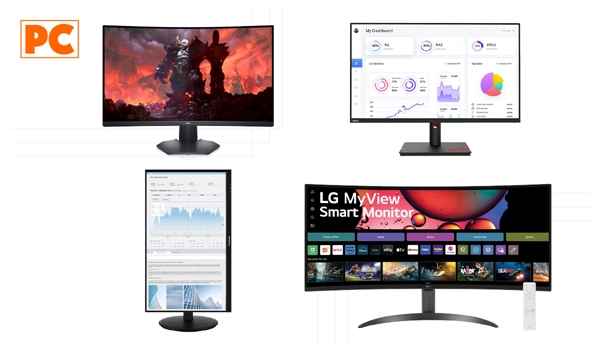
What Should You Know Before Buying a Monitor?
Selecting the perfect monitor can be as crucial as choosing any other component of your computer, especially if you consider the hours you will spend in front of it. Whether for work, gaming, or just browsing, the right monitor enhances your visual experience and can be an investment in your health and productivity:
What will be the main use of the monitor?
When you set out to buy a monitor, one of the most critical factors to consider is its intended use. The purpose for which you need the monitor will influence every decision, from resolution to panel type and additional features. Here we guide you on how to choose the monitor according to the use you will give it:
- Are you looking for a Gaming Monitor?: Gaming demands monitors that can keep up with fast action and provide an immersive experience. Although 1080p is still popular, gamers are migrating to 1440p (2K) for better detail without a prohibitive cost in performance. 4K is ideal if your hardware can handle it smoothly. Look for monitors with refresh rates of 144Hz or higher. Competitive gaming benefits greatly from this.
- Are you looking for a Monitor for Design, Video, or Photography?: 4K is almost a standard, offering the space and sharpness needed for detailed work. A monitor with a wide color gamut (100% sRGB, Adobe RGB) and calibration capability is essential.
- Are you looking for a Monitor for General Use and Office?: A Full HD or 1440p monitor with a good IPS or VA panel will offer a good visual experience without needing advanced features. Basic tilt or height adjustments can significantly improve comfort. Additionally, having multiple input options (HDMI, DisplayPort, USB-C) can be useful for connecting various devices.
What is your available budget?
Budget is one of the determining factors when selecting a monitor. This not only dictates the range of products you can access but also the features and quality you can expect. Here we help you understand how your budget can influence your choice:
- Budget Monitors: In this range, you will find basic monitors, generally 21 to 24 inches, with a resolution of 1080p. TN panels are more common due to their lower cost, offering fast response times ideal for casual gaming, although with limited colors and viewing angles. These are perfect for basic office tasks, studies, or as a second monitor. These monitors usually cost less than 150 dollars.
- Mid-range Monitors: Here you start to see monitors with IPS or VA panels, offering better image quality and viewing angles. The resolution remains 1080p at the lower end of this range, but you can find 1440p options. This range is excellent for users looking for a significant improvement in image quality without spending much, suitable for basic design, more demanding gaming, and general use with a better visual experience. You can consider these monitors in a range between 150 and 300 dollars.
- High-end Monitors: Monitors with resolutions of 1440p or even 4K become accessible. They include features such as high refresh rates (120Hz or more), very low response times, and synchronization technologies such as G-Sync or FreeSync. IPS panels dominate with their excellent color fidelity. They are ideal for serious gamers, design and video professionals, and users who want a high-quality visual experience for entertainment or productivity. You can consider these monitors in a range between 300 and 600 dollars.
- Premium Monitors: In this segment, you will find monitors with all the advanced features: 4K or ultrawide, high refresh rates, 1ms response times, HDR, professional color calibration, and advanced ergonomics. They are ideal for creative professionals who need color accuracy and detail, enthusiastic gamers seeking maximum immersion and performance, and for those who want no compromises in quality. You can find these monitors for over 600 dollars.
What are the technical specifications to consider in Monitors?
The key to making an informed decision lies in understanding the technical specifications that define the quality and functionality of a monitor. From the resolution that determines the clarity of the image to the refresh rate that affects the smoothness of the movement on the screen, every detail matters. Here we leave you the most relevant technical specifications in monitors:
Resolution:
Resolution is one of the most important aspects when choosing a monitor. It affects the image quality and the amount of content you can view on the screen without losing clarity. Resolutions to consider are as follows:
- Full HD (1920x1080): This is the standard resolution and is ideal for everyday office tasks, web browsing, and some gaming. It is an accessible and effective option if you do not have advanced graphic needs.
- 2K (2560x1440): Also known as QHD, it's excellent for those looking for more detail, whether in gaming, design, or multimedia work. It offers more pixels than Full HD, providing a sharper image without reaching 4K levels.
- 4K (3840x2160): The preferred option for graphic designers, video editors, and gamers who want the best visual experience. With four times more pixels than Full HD, 4K monitors offer an impressive level of detail but require a powerful graphics card.
- 5K and 8K: These monitors are more oriented towards professionals working with ultra-high-resolution images or video editors who need to visualize multiple details simultaneously. They are more expensive and are not yet widely seen.
Monitor Size:
The size of the monitor is directly related to the resolution and the space available on your desk. A larger monitor is not always the best option, especially if you are going to use it in a small space.
- 21 inches or less: These are ideal in environments where space is limited, or where a secondary monitor is needed, these devices are perfect. In classrooms or for students with limited space at home, these monitors offer a practical solution without sacrificing functionality. Although they do not offer the same field of view as their larger counterparts, their utility in certain contexts makes them indispensable.
- 22 to 24 inches: These are the most compact sizes, ideal for small spaces or desks where too much screen is not required. They are common in offices and homes where the main tasks include browsing the internet, working on documents, or doing video calls. This size is suitable for office work, general home use, web browsing. The recommended resolution for these is Full HD (1920x1080), as in these sizes a higher resolution is not needed to obtain a sharp image.
- 25 to 27 inches: Perfect for those seeking a larger screen without sacrificing too much space. It is popular among designers, gamers, and those needing multitasking. This size has gained popularity because it provides an excellent balance between screen space and image quality. It is perfect for multitasking, photo or video editing, gaming, and viewing multimedia content. 27-inch monitors usually offer resolutions from Full HD to 4K, the latter being ideal for those seeking maximum detail.
- 28 inches or more: These monitors are ideal for immersive gamers, designers, and editors who need wide screens to multitask simultaneously. However, it is from 32 inches that monitors begin to stand out in productivity, immersive entertainment, and advanced graphic design. 32-inch monitors are ideal for those needing a lot of workspace to work with multiple open windows at once or for those looking for a more immersive gaming or home theater experience. It is recommended that these have a 4K resolution, as the size requires more pixels to maintain excellent image quality.
Refresh Rate and Response Times:
The refresh rate (measured in Hz) indicates how many times per second the image on the screen is updated. This aspect is crucial if you play video games, as a higher refresh rate provides you with a smoother experience. The response time refers to how quickly a pixel can change color. The lower the response time (measured in milliseconds), the less motion blur there will be on the screen, which is fundamental for gaming. For the frequencies to consider we have:
- 60Hz to 75Hz: This is the standard in most monitors. Suitable for daily use, such as web browsing or office work.
- 120Hz to 144Hz: Monitors with these frequencies are perfect for gamers looking for a smoother experience in fast-paced games. The difference is noticeable compared to 60Hz.
- 240Hz or more: Recommended for professional gamers or people playing esports titles where reaction speed is crucial.
Panel Type:
The type of panel determines image quality, viewing angles, and response time. Here we explain the three main panel technologies:
- IPS (In-Plane Switching): They offer better viewing angles and excellent color accuracy. They are ideal for graphic design work, video editing, and for those seeking superior image quality. They are more expensive and often have slightly higher response times than TN panels.
- TN (Twisted Nematic): These panels are popular in gaming monitors due to their low response time and high refresh rate. However, they have poorer viewing angles and less vibrant colors than IPS panels.
- VA (Vertical Alignment): A balance between IPS and TN. They offer good viewing angles and solid colors, but are often not as fast as TN. They are ideal for curved and multimedia monitors.
Connectivity:
An often overlooked aspect is the connectivity of the monitor. Ensure that it has the appropriate ports for your devices:
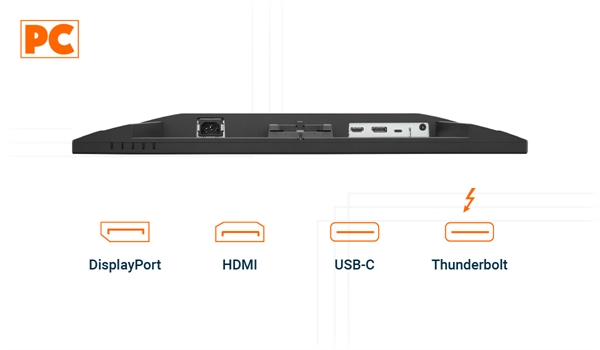
- HDMI: This is the most common port and is found on most modern monitors. Ideal for connecting consoles, laptops, and computers.
- DisplayPort: Offers better support for high resolutions and refresh rates. It is the preferred option for gamers and professionals.
- USB-C: It is becoming very popular in high-end monitors as it allows data, image, sound transfer, and device charging with a single cable.
- Thunderbolt: Provides fast and reliable connections, especially on Apple devices.
Is a Monitor Stand Important?
When choosing the perfect monitor for you, you should not only consider its technical features, such as resolution, size, and refresh rate, but also how it integrates into your work or gaming space. A proper monitor stand is essential to maximize the comfort and ergonomics of your setup. Monitor stands allow you to adjust the height, tilt, and rotation of the screen, helping to prevent eye and postural fatigue. Additionally, a well-designed stand can free up space on your desk, keeping your work area neat and organized.
If you are interested in a specific stand, we recommend reading our article Review: Klip Xtreme KPM-310 Monitor Stand. In this blog, we analyze the features, advantages, and disadvantages of this model, so you can decide if it is the right choice for you. Don't underestimate the importance of a good monitor stand; it can make a huge difference in your daily user experience.
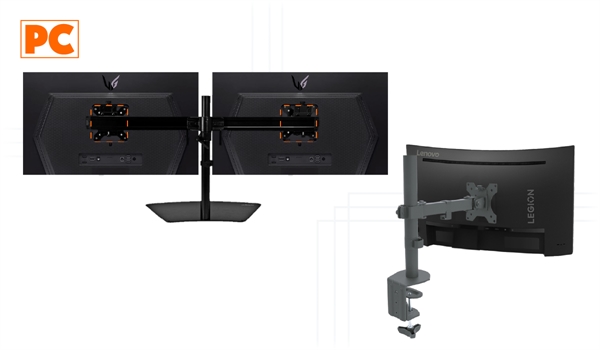
Flat Monitors or Curved Monitors: Which option should you choose?
Both options have their advantages, but the choice depends on your specific needs, your work or entertainment environment, and, of course, your personal preferences. The decision between a flat monitor and a curved one can significantly impact your visual experience. Your choice between a flat or curved monitor should be based on how and where you plan to use it. Consider not only the technical specifications but also your comfort and the aesthetic impact on your workspace or gaming space.
Flat Monitors
Flat monitors have been the standard option for years. They are rectangular and, as their name indicates, have a completely flat surface. While they do not offer the immersive experience of curved monitors, they remain very popular due to their versatility and ease of use in any environment. They are ideal for professionals working with graphics, images, and video editing, users with smaller desks or simple setups, and for those looking for a more economical option without sacrificing functionality.
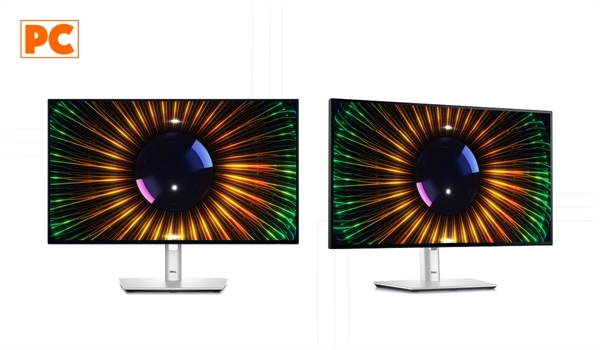
Advantages of Flat Monitors:
- Universal Compatibility: Flat monitors fit nearly any desk or workspace setup, whether at home or in the office.
- Visual Accuracy: Flat monitors are ideal for work that requires precision, such as graphic design and photo editing, as they do not distort images at the edges.
- More Affordable: Generally, flat monitors tend to be more budget-friendly than curved monitors of the same category.
- Easy Installation: They do not require special setups or additional space considerations.
Disadvantages of Flat Monitors:
- Immersion: They do not offer the same immersive feeling as curved monitors, especially with larger monitors.
- Viewing Angles: Although they have improved, the edges of a flat monitor can be less visible if you are sitting very close or at extreme angles.
Curved Monitors
Curved monitors, on the other hand, are designed to slightly wrap the screen around the user’s field of vision, creating a sense of immersion that flat monitors cannot offer. This curve reduces distortion at the edges and allows for a more natural viewing experience by following the curvature of the human eye.
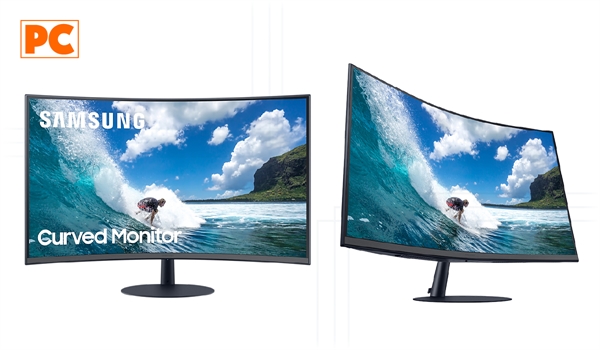
Advantages of Curved Monitors:
- Immersion: The curvature of the monitor provides a wrapping sensation that can make you feel more immersed in the content, whether for gaming, watching movies, or working.
- Distortion Reduction: The curvature reduces image distortion at the edges, enhancing clarity and photorealism.
- Visual Comfort: It may be less straining on the eyes during long work or gaming sessions, especially with larger monitors.
- Aesthetics: Curved monitors have a visual appeal that can be attractive in both professional and personal settings.
Disadvantages of Curved Monitors:
- Cost: Generally more expensive than flat monitors with similar specifications.
- Space: They require more desk space and can be more difficult to accommodate in multi-monitor setups.
- Varied Use: While excellent for entertainment and gaming, they are not always the best option for tasks that require multiple windows or accurate flat views.
What Monitor Setup is Best for You?
The ideal monitor setup completely depends on your personal and professional needs, as well as your aesthetic and functional preferences. Here we guide you to discover which setup fits you best:

What monitor setup is best for gaming?
If you are a gamer, your visual experience is crucial for enjoying your games to the fullest. You should opt for monitors with at least 144Hz for a smooth experience, with a low response time; 1ms is ideal to reduce blur in fast games. FreeSync or G-Sync synchronization technology is necessary to avoid tearing. Having at least 1440p (2K) provides a good balance between graphic detail and performance, although 1080p is still popular for maintaining high refresh rates with less powerful hardware. Furthermore, curved monitors can offer better immersion, but flat monitors are more versatile and economical. Here, setups can vary depending on the type of game you prefer.
- Ultrawide Monitor Setup: An ultrawide monitor provides an immersive gaming experience, especially in open-world games, racing simulators, or any other title that benefits from a wider view. This type of monitor eliminates the need for a second screen, as it allows you to see more of the game in a single view.
- Dual Monitor Setup: One monitor for the main game and another for secondary tasks, such as online game chat or viewing guides, can be the best option for many players. Having two screens allows you to maintain immersion in the game while managing other activities without pausing or switching windows. This setup is ideal if you are gaming and streaming online simultaneously or if you need access to chats or additional information while playing.
What monitor setup is best for design?
Creative professionals, such as graphic designers, video editors, and photographers, need monitor setups that provide color accuracy, ample workspace, and multiple screens to manage several software tools simultaneously. Here, recommended setups may include:
- Ultrawide Monitor Setup: This type of monitor is ideal for creative professionals, as it allows them to work on large projects with multiple open windows without interruptions. The continuity offered by an ultrawide monitor is especially useful for video editing and graphic design projects. It is recommended if you work with editing or graphic design software that requires multiple toolbars and a wide view of the project. You also need a high-resolution monitor with color accuracy (sRGB, Adobe RGB, or DCI-P3) to ensure the visual quality of your work.
- Dual Monitor Setup with Vertical Orientation: A combination of a horizontal monitor for primary editing and a vertical monitor for viewing code, text, or additional tools can enhance efficiency in creative or technical tasks. This is recommended if you are a graphic designer who also works with text, code, or references and at the same time want to maximize the use of desk space with a more flexible setup.
What are the most popular monitor brands?
The most popular and respected brands in the world of monitors stand out for their technological innovation, product quality, and ability to meet different user needs. Here is a summary of the main monitor brands in Latin America and what makes them stand out a bit more in this market:
- Dell: This is one of the most popular brands in the monitor market, suitable for a wide variety of users, from office workers to creatives and gamers. Dell monitors are known for their excellent value for money, offering high-end resolutions and multiple connectivity options. Notable models include the Dell Ultrasharp and Dell P Series.
- LG: Has stood out for its advances in display technologies, such as OLED and Nano IPS, which have led its monitors to be among the most valued for creatives and gamers. The brand offers everything from budget models for home use to ultrawide and high-resolution monitors that provide an excellent visual experience. The most popular models are the LG UltraGear and LG UltraWide lines.
- ASUS: Has gained ground in the monitor market with its product range designed specifically for gamers and design professionals. Its monitors are known for offering ultra-fast refresh rates. Notable models include the ASUS ROG Swift and ASUS ProArt.
- Acer: Known for offering a range of budget-friendly monitors with competitive features, making them an excellent choice for those looking for an affordable monitor with good performance. Its monitors cover all categories, with the Acer Predator and Acer Nitro series being noteworthy.
- HP: This is a brand recognized for its quality and reliability in products for the office and home. Its monitors are characterized by their simplicity and effectiveness, with options ranging from models focused on daily productivity to high-end monitors for creative professionals, highlighting the HP Z Series and HP Pavilion lines. To learn more about the variety of products that HP sell in Latin America, visit our article What products does HP sell in Latin America?
- MSI: Although MSI is better known for its PC components and laptops, its monitors have gained popularity due to their dedication to the gaming market with features like high refresh rates.
- Xiaomi: Although better known for its smartphones, Xiaomi has entered the monitor market offering products with good value for money, attracting an audience seeking budget options without sacrificing much quality.
- AOC: Offers monitors with excellent display quality at competitive prices, being particularly popular among gamers for their high refresh rate monitors.
- Viewsonic: Offers monitors with a solid balance between price, performance, and features. Its products range from accessible models for home use to monitors with excellent color accuracy and premium features for video editors and creatives. Notable models include the ViewSonic VX Series and ViewSonic ColorPro.
Where can you buy monitors in Latin America?
In Latin America, there are various options, both physical and online, for buying monitors. You can find monitors in large electronics chains and specialized computer stores, which offer a variety of models with different specifications and mounting technologies. Also, global e-commerce platforms like Amazon are widely used; however, the inclusion of taxes in the final price sometimes results in higher prices. Some brands like Samsung and ASUS have direct presence with their products in official stores and authorized distributors throughout Latin America, offering products ranging from gaming to professional and design use. However, these physical stores often do not have a large availability of products, so we always recommend shopping at an online store that has a wide variety of available products for delivery, such as Pana Compu, which also has brand recognition regarding guarantees for all products.

Where can you buy monitors in Peru?
If you are in Peru and looking for where to buy monitors, Pana Compu is your best option. Here you will find a wide selection of monitors in Peru from all leading brands such as Samsung or Asus, and many more, which might not always be available in their official stores. At Pana Compu, we not only offer you the chance to acquire gaming monitors, high-performance, or graphic design monitors, but we also provide quality, warranty, and excellent after-sales service. You can pick up your monitor at no extra charge at any of our branches. Additionally, if you have any questions, our customer service team is available to resolve all your inquiries.
Where can you buy monitors in Panama?
Although there are official stores for brands like LG or Samsung in Panama, they do not always have all models in their physical establishments. Therefore, we recommend Pana Compu. Here you will not only find a wide range of monitors in Panama from all the brands and types mentioned in this blog, but we also guarantee quality, warranty, and exceptional after-sales service. Whether you are looking for a gaming monitor, high performance, or for graphic design, at Pana Compu we have what you need. You can purchase and collect your monitor at no additional cost at any of our branches. And if you still have doubts, our customer service is ready to assist you with any inquiries.
In summary: How to Choose the Perfect Monitor for You?
Choosing the right monitor involves considering your main use: for gaming, look for high refresh rates and low response times, opting for brands like Samsung or ASUS. If you are a creative professional, prioritize color accuracy and resolution with monitors like those from LG or BenQ. For general use or work, a balance between resolution, ergonomics, and price is key, with Dell or HP being good options. Most monitors are good enough to satisfy most people. The best monitors are not cheap.
Also, check the connectivity you need, the screen size that fits your space, and don’t forget the synchronization technology (G-Sync or FreeSync) if you are a gamer. Consider features like curvature for greater immersion or ergonomic adjustments for comfort during long periods of use. Remember that you can visit the Pana Compu page to discover even more monitors that meet your tastes and needs.
Comments
All opinions are of our customers friends. Join the conversation!
No comments yet... Be the first!